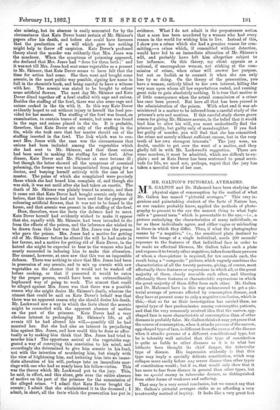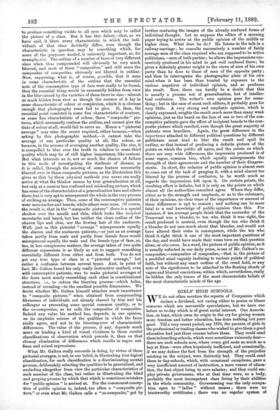MR. GALTON'S PICTORIAL AVERAGES.
MR. GALTON and Dr. Mahomed have been studying the physical signs of consumption by the method of what Mr. Galton has named " pictorial averages." This very in- genious and painstaking student of the facts of Nature has, as our readers probably know, applied the methods of photo- graphy to present to the eye the nearest thing to what logic calls a " general term " which is presentable to the eye,‚ÄĒi.e., picture embodying the characteristics of many individuals, so far as these individuals agree, and either vague or misleading- in those in which they differ. Thus, if what the photographer means by "a negative," i.e., the sensitized plate destined to receive the image of a single individual, needs 200 seconds' exposure to the features of that individual face in order to. be made an effectual likeness, Mr. Galton takes such a plate and exposes it to twenty other negatives, taken from those persons of whom a class-picture is required, for ten seconds each, the result being a " composite " picture, which vaguely combines the characteristics of all the twenty persons, giving, of course, most effectually those features or expressions in which all, or the great majority of them, closely resemble each other, and blurring effectually those features or characteristic expressions in which the great majority of them differ from each other. Mr. Galton and Dr. Mahomed have in this way endeavoured to get a pic- torial average of persons affected by consumptive disease, and they have at present come to only a negative conclusion, which is this,‚ÄĒthat so far as their investigation has carried them, no special type of face predominates among consumptive patients, and that the very commonly received idea that the narrow, egg- shaped face is more characteristic of consumption than of other diseases is probably false. Mr. Galton thinks it may yet prove that the course of consumption, when it attacks persons of the narrow, egg-shaped type of face, is different from the course of the disease when it attacks persons of a different constitutional type, but he is tolerably well satisfied that this type of constitution is quite as liable to other diseases as it is to what has hitherto been thought its chief danger, the tubercular type of disease. His impression evidently is that this type may imply a specially delicate constitution, which may collapse more easily before any severe disease than other types of constitution would ; but if so, that would only show that it has more to fear from disease in general than other types, but has no special enemy in tubercular disease, as distinguished from other forms of weakness and suffering.
That may be a very sound conclusion, but we cannot say that Mr. Galton's pictorial averages strike us as affording a very trustworthy method of inquiry. It looks like a very great feat to produce something visible to all eyes which may be called the picture of a class. But it has this defect,‚ÄĒthat, as we have said, it blurs every characteristic in which the indi- viduals of that class decidedly differ, even though the characteristic in question may be something which, for some of the purposes needed, is extremely important, as, for example, size. The outline of a number of faces of very different sizes when thus compounded will obviously be very much blurred, and most of these "composites," and still more the composites of composites, obviously are blurred in outline. Now, supposing, what is, of coarse, possible, that it were in some characteristic of the outline that the essential note of the consumptive type of face were really to be found, then the essential thing would be necessarily hidden from view in the blur caused by the varieties of these faces in size,‚ÄĒalmost as much hidden from view as though the essence of it lay in some characteristic of colour or complexion, which it is obvious enough that photography must fail to give. If, then, the essential point consisted in some fine characteristic of contour, or some fine characteristic of colour, these " composite " pic- tures, which necessarily confuse the outline, and cannot give the tints of colour at all, would fail to serve us. Hence a " pictorial average " may miss the secret required, either because,‚ÄĒwhen acting by this photographic method,‚ÄĒit cannot take the average of one particular quality at all, like colour, or because, in the process of averaging another quality, like size, it is compelled to blur over the truth in relation to some third quality which may be of still higher importance, like contour. But what interests us is, not so much the chance of failure in this mode of investigating the diathesis of disease, as it is called, through the missing of some feature necessarily blurred over in these composite pictures, as the illustration this gives us that by these physical methods you never can really arrive at what the thinker means by true generalisation at all, but only at a more or less confused and misleading picture, which has some of the characteristics of a generalisation here and others there, but is very apt to misrepresent the whole in the very process of striking an average. Thus, some of the consumptive patients wear moustaches and beards, while others wear none. Of course, the result is, that in the " composite picture" there is a special shadow over the mouth and chin, which looks like incipient moustache and beard, but has neither the clean outline of the shaven lips and chin, nor the flowing hair of the unshaven. Well, just as this pictorial " average " misrepresents equally the shaven and the unshaven patients,‚ÄĒor just as an average taken partly from male and partly from female faces would misrepresent equally the male and the female type of face, so, too, in less conspicuous matters, the average taken of two quite different expressions is as likely as not to suggest something essentially different from either and from both. You do not get any true type or class in a "pictorial average," but rather a confusion between several types. And, in point of fact,. Mr. Galton found his only really instructive method, even with consumptive patients, was to make pictorial averages of the faces most nearly resembling each other in constitutional structure, i.e., to reduce the blurring process‚ÄĒwhich hides, instead of revealing‚ÄĒto the smallest possible dimensions. We doubt whether Mr. Galton himself attaches much importance to "composite pictures " when obtained from compounding likenesses of individuals not already classed by him and his colleague as presenting some special common quality, or to the co-composites, as he calls the composites of composites. Indeed any value his method has, depends, in our opinion, on its emphatic seizure of the qualities in which the faces really agree, and not in its blurring-over of characteristic differences. The value of the process, if any, depends much more on lending a kind of visual vividness to those careful classifications of observation which precede it, than on that clumsy elimination of differences which results in vague out- lines and mixed expressions.
What Mr. Calton really succeeds in doing, by virtue of these pictorial averages, is not, in our belief, in illustrating true logical classification, for such classification is a discriminating mental process, deliberately selecting the qualities to be generalised, and excluding altogether from view the particular characteristics of each member of the class, but rather in illustrating the blind and groping process by which that which is sometimes mistaken for " public opinion " is arrived at. For the commonest concep- tion of public opinion is, indeed, too often a " composite pic- ture," or even what Mr. Galton calls a "co-composite," got by
further confusing the images of the already confused forms of individual thought. Let us suppose the editor of a morning paper trying to arrive at the public opinion of the middle or higher class. What does he do P He listens to the talk in a railway-carriage ; he consults successively a number of fairly average men of the class required who are supposed to be active politicians,‚ÄĒmen of both parties ; he allows the impressions suc- cessively produced is his mind to get well confused there; he gives a definitely greater weight to the views of men of his own Party than he does to those of men of the opposite party ; and then he interrogates the photographic plate of bis own mind when it has been thus treated by exposure to the various negatives of individual opinion, and so produces the result. Now, there can hardly be a doubt that this is usually a process not of generalisation, but of intellec- tual confusion. The writer's own opinion goes for some- thing ; but in the case of most such editors, it probably goes for very little. A very strong and emphatic opinion, which is clearly expressed, weights the result much more than many weak opinions, just as the beard on the face of one or two of the con- sumptive patients gave the effect of incipient beards to the com- posite picture which resulted, even though the great majority of patients were beardless. Again, the great difference in the importance attached to different political questions by different politicians must tend to blur the result and spoil its outline, so that instead of producing a definite picture of the points on which the public all agree, and the points on which there are very wide differences, the impression produced is of some vague, common bias, which equally misrepresents the strength of their agreements and the number of their disagree- ments. In short, the redactor of public opinion is almost sure to come out of the task of ganging it, with a mind almost too blurred by the process of confusion, to be worth much as regards the impressions left upon it. On certain points, the resulting effect is definite, but it is only on the points on which almost all the authorities consulted agree. Where they differ, either as to the strength and emphasis, or as to the substance, of their opinions, no clear trace of the importance or amount of these differences is apt to remain ; and nothing can be more fatal to a real knowledge of public opinion than this. For instance, if ten average people think that the surrender of the Transvaal was a blunder, to ten who think it was right, the result produced is neutral, even though the ten who think it a blunder do not care much about that blunder, and would not have altered their votes in consequence, while the ten who think it right think it one of the most important questions of the day, and would have made their votes turn on that question alone, or vice versa. In a word, the picture of public opinion, as it is usually reflected in our daily press, is one of Mr. Galton's co- composites,‚ÄĒcomposites of composites,‚ÄĒthat is, the picture of a muddled mind vaguely inclining to various points of political faith, but without any exact outline of the creed held, or any note of the significance to be attached to the floating clouds of vague and blurred convictions, within which, nevertheless, really lie hidden the only traces of the most characteristic beliefs of the most characteristic minds of the age.















































 Previous page
Previous page